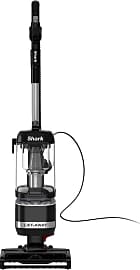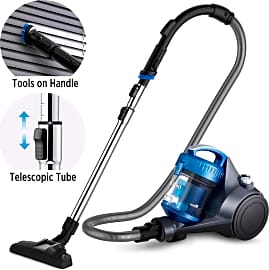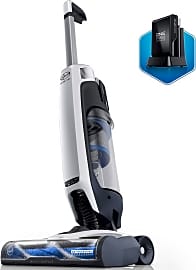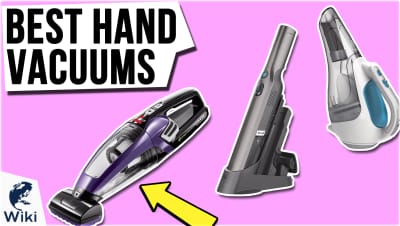The 10 Best Bagless Vacuums

This wiki has been updated 38 times since it was first published in June of 2015. Chances are that you're not going to proclaim house cleaning as your absolute favorite pastime. But if you're tired of dealing with overpriced and messy bags just to remove the dust, dirt, and debris from the floors and carpets in your home, consider using one of these bagless vacuums as an alternative. Many of our options include swivel-head steering and innovative cyclonic suction power. When users buy our independently chosen editorial picks, we may earn commissions to help fund the Wiki.
Editor's Notes
July 23, 2021:
We made a few worthwhile changes to the list upon revisiting, and they were all basically upgrades to previous selections. The Shark Navigator LA322 is our favorite lightweight option and does a great job at keeping allergens out of the air. The Bissell Pet Hair Eraser Turbo Plus is one of the best on the market at cleaning pet hair, and in fact separates it in the chamber to keep cleaning power high even when there's plenty of fur already collected. Finally, the Hoover ONEPWR Evolve is our new top battery powered model and performs very well on both carpet and hard flooring.
April 10, 2020:
We updated this list considerably, replacing four of our previous entries.
To maintain a budget-friendly option after removing the Dirt Devil Power Air, we added the Bissell Featherweight. This unit is surprisingly affordable, and offers a lot of versatility. Its ability to turn into a dust buster-style hand-held vacuum is convenient and would be great for spot-cleaning dry dirt or food spills. It lacks the roller-brush needed to effectively tackle carpeting, so homeowners with rugs and carpet would probably want a more robust model. This option would be ideal for smaller homes or apartments with all hardwood or laminate floors.
We also added a canister-style option for people looking for more maneuverability. This type of vacuum separates the wand from the rest of the machine with a long hose, providing the user with more range of motion and mobility. The rest of the unit is wheeled behind as you work, and since their components don’t need to fit into a narrow upright body, these vacuums can get away with having larger motors. Our new canister entry, the Eureka Whirlwind, is a powerful model at a reasonable price. Its 8-pound weight makes it easy to carry when going upstairs, and a convenient retractable power cord is a nice time-saver. Its segmented design does make it more of a challenge to store however, so keep that in mind.
Even though bagless vacuums are convenient and eco-friendly, they can also be difficult to empty correctly. Since dirt and debris are contained in a chamber, instead of an airtight bag, it's easy for contaminants to spill and escape into the air when dumping it out. Exposure to this dust can be dangerous to people with allergies, so emptying the vacuum should be done by someone else.
Bags Be Gone: Innovation In The Making
Finally, this clean air passes through two HEPA filters before it is blown back into the room.
Similar to most traditional vacuums, a bagless vacuum cleaner makes use of an internal centrifugal fan to create suction for picking up contaminants from both floors and upholstery. The fundamental differences lie in its use of internal filters to separate dust and debris from clean air as well as its use of a plastic collection cup to gather the debris during a vacuuming session.
Some bagless vacuums remove particulates from the air through cyclonic separation. This process causes intake air to accelerate to such a speed that dust and other particulates are forced out of the air and into a collection bin. Bagless vacuums utilizing this type of action with filters are referred to as cyclonic models, while those using only filters are considered non-cyclonic in operation.
Non-cyclonic bagless vacuums have several major parts, including the inlet, collection bin, high-efficiency particulate air filter (HEPA), a motor unit, and an outlet grille for releasing clean air back into the room. The inlet normally attaches to the vacuum's cleaning head, while the collection bin is located toward the front of the unit. The HEPA filter is a cylinder of folded paper attached to the base of the collection bin. Air is sucked through the HEPA filter and only the dirt is left behind in the collection bin. The motor unit is also located near the base of the vacuum and powers its suction.
Cyclonic vacuums, such as those designed by Dyson Ltd, include similar parts with the addition of a cyclone component. The cyclone attachment takes the form of a tapering, cone-shaped piece of plastic with many holes at the top. When the electric motor is active, dirty air is first sucked up to the top of the large cyclone where it whirls around at very high speeds. While the air is drawn through the cone holes, dirt and debris are separated out and fall to the bottom of the vacuum's collection bin. The somewhat cleaner air that still remains then passes through a second level of cyclonic filtration through a series of smaller cyclone components. These smaller cyclones remove much finer dirt particles from the air. Finally, this clean air passes through two HEPA filters before it is blown back into the room.
Regardless of whether a bagless vacuum is cyclonic or non-cyclonic, it is typically more cost-effective than its bagged counterparts, since the user doesn't have to worry about the expense of replacement bags. The collection bin can simply be emptied, cleaned, and reused for the life of the machine. As a vacuum bag fills up, the device's performance and efficiency are compromised. This places further strain on the vacuum's electric motor, which doesn't occur with bagless operation. It's also difficult to know exactly when a vacuum bag is full without a visual indicator. By contrast, a clear plastic collection bin on a bagless vacuum is easy to see, allowing the user to determine when it needs to be emptied and cleaned.
Convenience And Ease While Vacuuming
A vacuum cleaner with a traditional collection bag is somewhat counterproductive to the whole purpose of cleaning in the first place. The goal of a vacuum is to suck up and discard dirt, dust, and other contaminants from the floor, not to store them inside a bag until it reaches capacity and requires removal and replacement for an additional expense.
This detraction paves the way for the use of a bagless vacuum in one's home.
A bagged vacuum cleaner ends up blowing at least some amount of dirty, dusty air back into a room where it is redeposited onto the floor. This detraction paves the way for the use of a bagless vacuum in one's home.
Because a vacuum cleaner can be a large device to handle, both power and ease of maneuverability should be considered when investing in a bagless unit. The vacuum's components should also be easy to access (e.g. emptying the collection tray).
Many bagless vacuums offer cordless operation while running on lithium batteries among other types. This makes it much easier to use the device in multiple rooms, so it's worth investing in one with a reliable battery life for extended use.
One must also be sure to look for a bagless model with adjustable height options, particularly if the device will be used on both hard floors and rugs throughout the house.
A Brief History Of Bagless Vacuums
The concept of the vacuum cleaner dates back to Chicago inventor Ives W. McGaffey and his 1868 device called the Whirlwind. This device was quite bulky and worked with a belt-driven fan that had to be cranked by hand across the floor, which made it awkward and cumbersome to operate. Suffering from both allergies and asthma, Melville R. Bissell of Grand Rapids, Michigan invented the first successful mechanical carpet sweeper in 1876.
Booth's device was large and originally powered by an oil engine before being developed into an electric model.
The first motorized vacuum cleaner was developed by British inventor Hubert Cecil Booth in 1901, which Booth called the Puffing Billy. Booth's device was large and originally powered by an oil engine before being developed into an electric model. However, both of Booth's models were bulky and required transport by horse-drawn carriage. By 1907, an Ohio department store janitor named James Murray Spangler invented the first portable electric vacuum cleaner and was granted a patent for what he called the electric suction sweeper in 1908.
Funding problems forced Spangler to sell his patent to leather goods manufacturer William Henry Hoover, who redesigned Spangler's machine to include a steel casing, casters, and attachments. Hoover then founded the Hoover Company in 1922, which is still one of the most successful vacuum manufacturers today.
Following World War Two, vacuum cleaners became more common for the middle class. The end of the twentieth century saw further advancements in vacuuming technology, including cyclonic dirt separation, which was pioneered by James Dyson in the early 1980s as one of the first bagless vacuums, which are still popular today.















